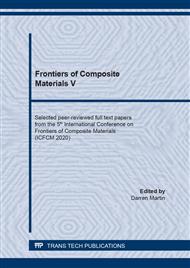[1]
P.J. Antony and N. M. Sanghavi. A New Binder for Pharmaceutical Dosage Forms. Drug Development and Industrial Pharmacy. Vol. 23, (1997).
DOI: 10.3109/03639049709146147
Google Scholar
[2]
F. Paul, A. Morin, and P. Monsan. Microbial polysaccharides with actual potential industrial applications. Biotechnology Advances. Vol. 4, (1986).
DOI: 10.1016/0734-9750(86)90311-3
Google Scholar
[3]
D. R. Pereira, J. Silva-Correia, S. G. Caridade, J. T. Oliveira, R. A. Sousa, A. J. Salgado, J. M. Oliveira, J. F. Mano, N. Sousa, and R. L. Reis. Development of Gellan Gum-Based Microparticles/Hydrogel Matrices for Application in the Intervertebral Disc Regeneration. Tissue Engineering Part C: Methods. Vol. 17, (2011).
DOI: 10.1089/ten.tec.2011.0115
Google Scholar
[4]
S. N. Jannah and M. A. Khairul. Bilayer materials consisting chitosan film with norfloxacin and gellan gum hydrogel with ibuprofen for dressing application. Frontiers in Bioengineering and Biotechnology. Vol. 4, (2016).
DOI: 10.3389/conf.fbioe.2016.02.00014
Google Scholar
[5]
C. J. Ferris, K. J. Gilmore, S. Beirne, D. Mccallum, G. G. Wallace, and M. I. H. Panhuis. Bio-ink for on-demand printing of living cells. Biomater. Sci. Vol. 1, (2013).
DOI: 10.1039/c2bm00114d
Google Scholar
[6]
Y. Sultana, M. Aqil, and A. Ali. Ion-Activated, Gelrite®-Based in Situ Ophthalmic Gels of Pefloxacin Mesylate: Comparison with Conventional Eye Drops. Drug Delivery. Vol. 13, no. 3, (2006).
DOI: 10.1080/10717540500309164
Google Scholar
[7]
A. Rozier, C. Mazuel, J. Grove, and B. Plazonnet. Functionality testing of gellan gum, a polymeric excipient material for ophthalmic dosage forms. International Journal of Pharmaceutics. Vol. 153, (1997).
DOI: 10.1016/s0378-5173(97)00109-9
Google Scholar
[8]
F. Pati, S. Dhara, and B. Adhikari. Fish collagen: A potential material for biomedical application. IEEE Students Technology Symposium (TechSym), (2010).
DOI: 10.1109/techsym.2010.5469184
Google Scholar
[9]
R. Parenteau-Bareil, R. Gauvin, and F. Berthod. Collagen-Based Biomaterials for Tissue Engineering Applications. Materials. Vol. 3, (2010).
DOI: 10.3390/ma3031863
Google Scholar
[10]
K. P. Rao. Recent developments of collagen-based materials for medical applications and drug delivery systems. Journal of Biomaterials Science, Polymer Edition. Vol. 7, (1996).
DOI: 10.1163/156856295x00526
Google Scholar
[11]
Z. Wang, S. Hu, and H. Wang. Scale-Up Preparation and Characterization of Collagen/Sodium Alginate Blend Films. Journal of Food Quality. Vol. 2017, (2017).
DOI: 10.1155/2017/4954259
Google Scholar
[12]
L.-F. Wang and J.-W. Rhim,. Preparation and application of agar/alginate/collagen ternary blend functional food packaging films. International Journal of Biological Macromolecules. Vol. 80, (2015).
DOI: 10.1016/j.ijbiomac.2015.07.007
Google Scholar
[13]
Tangsadthakun C, Kanopanont S, Sanchavanakit N, Banaprasert T and Damrongsakkul. Properties of Collagen/Chitosan Scaffolds for Skin Tissue Engineering. Journal of Metals, Materials and Minerals. Vol. 16, (2006).
Google Scholar
[14]
P. Pawar, G. Khurana, and S. Arora. Ocular insert for sustained delivery of gatifloxacin sesquihydrate: Preparation and evaluations. International Journal of Pharmaceutical Investigation. Vol. 2, (2012).
DOI: 10.4103/2230-973x.100040
Google Scholar
[15]
J. M. Blondeau. The Role of Fluoroquinolones in Skin and Skin Structure Infections. American Journal of Clinical Dermatology. Vol. 3, (2002).
Google Scholar
[16]
I. Abu-Yousef, D. Prabu, A. Majdalawieh, K. Inbasekaran, T. Balasubramaniam, N. Nallaperumal and C. Gunasekar. Preparation and characterization of gatifloxacin-loaded sodium alginate hydrogel membranes supplemented with hydroxypropyl methylcellulose and hydroxypropyl cellulose polymers for wound dressing.
DOI: 10.4103/2230-973x.177810
Google Scholar
[17]
K. Kataria, A. Gupta, G. Rath, R. Mathur, and S. Dhakate. In vivo wound healing performance of drug loaded electrospun composite nanofibers transdermal patch. International Journal of Pharmaceutics. Vol. 469, (2014).
DOI: 10.1016/j.ijpharm.2014.04.047
Google Scholar
[18]
B. Gupta, R. Agarwal, and M. S. Alam. Antimicrobial and release study of drug loaded PVA/PEO/CMC wound dressings. Journal of Materials Science: Materials in Medicine. Vol. 25, (2014).
DOI: 10.1007/s10856-014-5184-6
Google Scholar
[19]
N. J. Mohd Sebri and K. A. Mat Amin. Composite Film of Chitosan Loaded Norfloxacin with Improved Flexibility and Antibacterial Activity for Wound Dressing Application Oriental Journal of Chemistry. Vol, 33, (2017).
DOI: 10.13005/ojc/330210
Google Scholar
[20]
K. Nevin and T. Rajamohan. Effect of Topical Application of Virgin Coconut Oil on Skin Components and Antioxidant Status during Dermal Wound Healing in Young Rats. Skin Pharmacology and Physiology. Vol. 23, (2010).
DOI: 10.1159/000313516
Google Scholar


